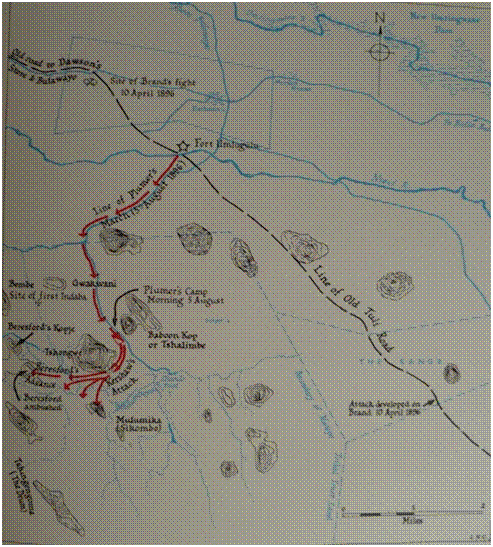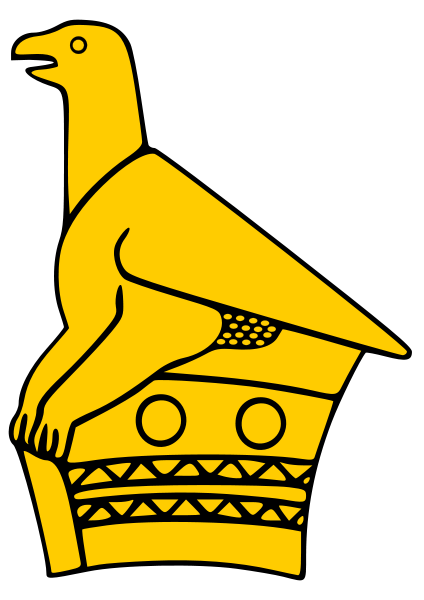Pioneer Days
War Drums...
Tshinengoma was to prove a pivotal encounter. The battle, also known as Sikombo's Fight, after the main Matabele commander, was a decisive encounter. Plumer led his men down the Tuli gorge, aggressively probing for weaknesses and actively looking for a fight. A Camp was formed at Sugar Bush (later called Umlugulu Fort) and the whites bunkered down. They were facing approximately 4000 Matabele under the joint command of Sikombo, Umlugulu and Nyanda. On August 5, Plumer launched his attack against the mountain stronghold of Tshinengoma. Despite his preparedness and extra troops, it was almost a disaster for the resilient Englishman.

Map showing the battle of August 5 (Modified from Ransford 1968)
Ebb and Flow of Fortune in Battle
Before they could access the stronghold, the whites had to traverse a deep valley, described by a correspondent for the Rhodesia Weekly Review as “a veritable valley of the shadow of death”. Captain Beresford was sent in and began an arduous ascent of the hill named Malumika; about 3000 Matabele surrounded his small force and attacked. En masse, Beresford's friendlies dropped their guns and either fled or suddenly joined the Matabele fighters. Signaling for help, Beresford formed his men into a square and was able to hold his own against vastly superior numbers. Lieutenant Harvey was ordered to dislodge a group of Matabele soldiers who had taken a position amongst some boulders overlooking the battleground. He and his sergeant were killed in the attempt and Baden-Powell (1896: 209) remarks with some disdain, “his place was at once gallantly taken by Mr. Weston Jarvis, who had sauntered out with a gun to look at the fun but proved himself a cool and able leader in a tight place”. Unusually, Sykes (1897: 197-198) and Baden-Powell (1897: 210) disagree on what happened next regarding the incredibly brave action of Captain Hoel Llewellyn in manning a maxim gun single-handedly and saving the whole regiment from destruction. Sykes claims Llewellyn did not want to expose his men to needless danger and thus ordered them to remain under cover while he checked the rapid advance of the Matabele, at one point firing almost point blank into their ranks. Baden-Powell acknowledges Llewellyn's bravery although gives a different reason, claiming the gunners misunderstood an order to take cover and abandoned their gun. Recognising the danger of such a gap in the ranks, Llewellyn dashed to the gun and began firing into the attacking group of Matabele soldiers. Beresford sent up a signal rocket that broght the fight to a pause (“the weird notes were heard of Sikombo's war-horn... with a sound like that of steam siren [Baden-Powell 1897: 213]) and almost at the same time, Plumer received the initial call for help. Although the fight was all but over, Plumer sent in three regiments, an action that was to lose him a close friend.
What happened?
Major Kershaw led an assault on the almost vertical granite walls of Malumika under scathing fire. It was an awful climb, hot and heavy going. “The Major, disdainful of danger or fatigue pushed on closely followed by Sergeant-Major McCloskie, Troopers Baron, Cawthorne and others. Hardly had they climbed a dozen steps, when a rebel hidden behind a rock fired the fatal shot, only to be himself in his turn shot dead by Baron” (Sykes 1897: 195). McCloskie was shot through the mouth and died as well. “Major Kershaw's death was a severe loss to the force. In this and other actions he had shown himself a particularly able and gallant officer, and with his quiet unassuming manner he had won the respect and affection of all ranks”. Plumer's (1897: 179) words hide a great deal of grief and perhaps gloss over a certain impetuosity on the part of Kershaw who by being in the thick of the battle was not as unassuming as claimed. Sykes (1897: 200) had a different eulogy: “The word fear had no meaning for him, his intrepidity in many cases amounting almost to recklessness”.
Another turning point?
This was the costliest battle of the whole war – for both sides. The whites lost seven men killed (some died later of wounds received) and 11 wounded. Two Cape Boys were also killed in this the last major engagement of the Matabeleland war. Plumer (1897: 178-179) estimated that over 3000 Matabele soldiers and allies were involved in the battle, losing almost 200 men. “It was the severest engagement we had had, the rebels fighting with great determination and, in some instances, with desperate courage” (Plumer 1897: 179). A couple of days later, a patrol travelling through a valley Mark Twain would have described as “straighter than a corkscrew but not as straight as a rainbow” captured some Matabele cattle and were later set upon in what was the last skirmish in the war. The date was August 9 and things were about to change. Rhodes had arrived.
Sourced from the Zanj Financial Network 'Zfn', Harare, Zimbabwe, email briefing dated ? 2011


 South Devon Sound Radio
South Devon Sound Radio Museum of hp Calculators
Museum of hp Calculators Apollo Flight Journal
Apollo Flight Journal Apollo Lunar Surface Journal
Apollo Lunar Surface Journal Cloudy Nights Classic Telescopes
Cloudy Nights Classic Telescopes The Savanna - Saffer Shops in London
The Savanna - Saffer Shops in London Linux Mint
Linux Mint Movement for Democratic Change
Movement for Democratic Change